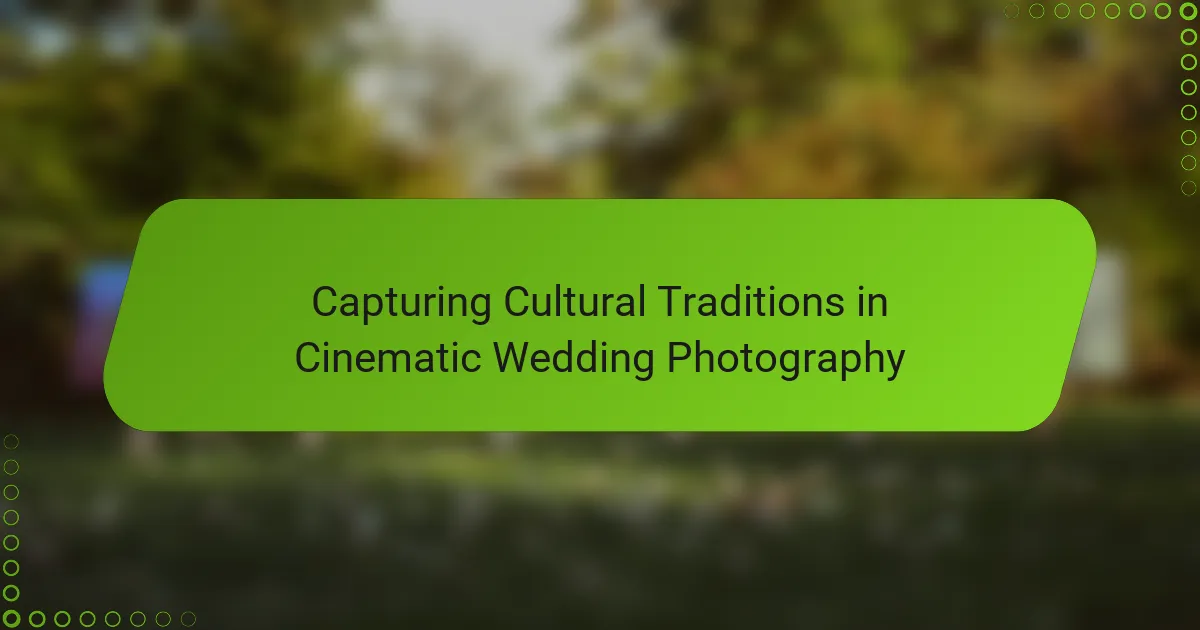Cinematic wedding photography offers a unique opportunity to capture the rich tapestry of cultural traditions that define a couple’s heritage. By focusing on elements such as traditional attire, rituals, and significant locations, photographers can create a visually stunning narrative that honors the couple’s background. Utilizing techniques like natural lighting and storytelling angles enhances the overall experience, ensuring that every cherished moment is beautifully preserved.
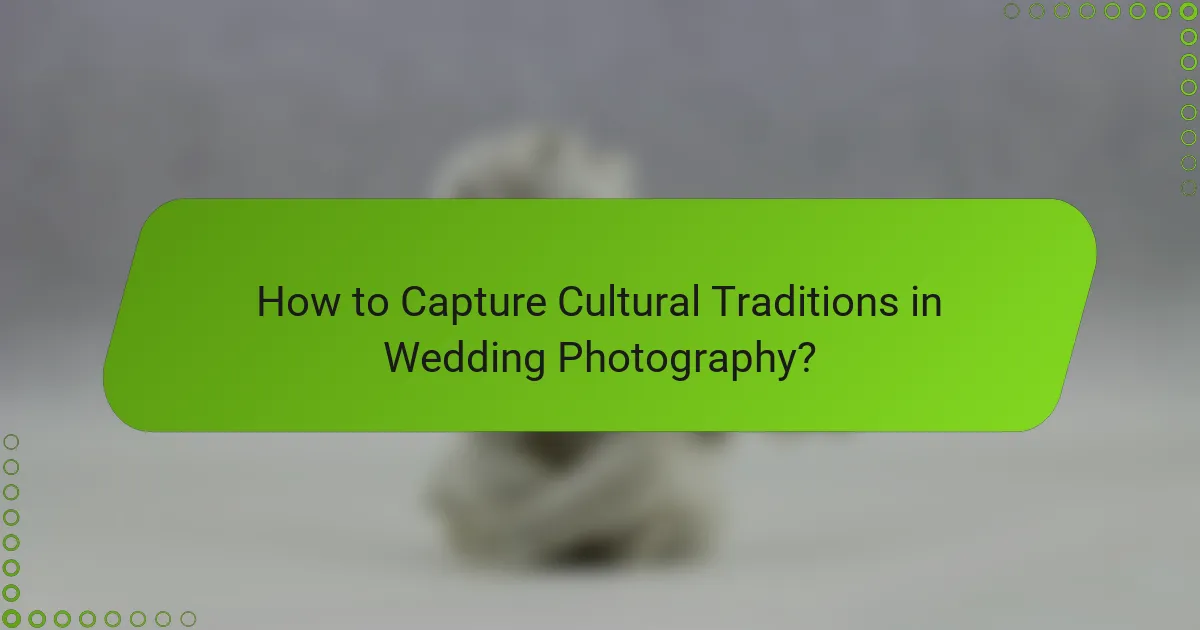
How to Capture Cultural Traditions in Wedding Photography?
To effectively capture cultural traditions in wedding photography, focus on the unique elements that define the couple’s heritage. This includes traditional attire, rituals, family heritage, local customs, and significant locations that hold meaning for the couple and their families.
Incorporate traditional attire
Traditional attire is a vital aspect of cultural identity in weddings. Photographers should ensure they capture the intricate details and vibrant colors of garments that reflect the couple’s heritage. For example, Indian weddings often feature elaborate saris and sherwanis, while Scottish weddings may showcase kilts.
Encourage couples to wear outfits that represent their backgrounds, and consider scheduling a pre-wedding shoot to highlight these garments in a meaningful context. This approach not only enhances the visual storytelling but also honors their cultural roots.
Utilize cultural rituals
Cultural rituals are central to many wedding ceremonies and provide rich photographic opportunities. Be aware of key rituals such as the tea ceremony in Chinese weddings or the breaking of the glass in Jewish ceremonies. Understanding these practices allows photographers to anticipate moments that are significant to the couple and their families.
Coordinate with the couple to create a timeline that includes these rituals, ensuring you are prepared to capture them authentically. This preparation helps in documenting the emotional weight and cultural significance of each ritual.
Highlight family heritage
Family heritage plays a crucial role in weddings, often influencing traditions and customs. Photographers should aim to include family members in key moments, such as during the vows or dances, to showcase the support and love that surround the couple.
Consider creating a family tree or a visual timeline that highlights important ancestors or family traditions. This can add depth to the photography, making it not just about the couple but also about their families’ legacies.
Engage local customs
Local customs can vary widely and add unique flavor to wedding photography. Research the specific customs of the region where the wedding takes place, whether it’s a traditional dance, a specific type of food, or local music. Engaging with these customs can provide a richer narrative in the photographs.
Work with the couple to incorporate these local elements into the shoot, ensuring that the final images reflect the cultural context of the wedding. This can enhance the authenticity and emotional resonance of the photography.
Document significant locations
Significant locations often hold sentimental value for the couple and can enhance the storytelling aspect of wedding photography. Identify places that are meaningful, such as the venue where the couple met or a family home where traditions are celebrated.
Plan to include these locations in the photography, utilizing natural light and the surrounding environment to create compelling images. This approach not only captures the wedding day but also the couple’s journey and connection to their cultural roots.

What Are the Best Techniques for Cinematic Wedding Photography?
The best techniques for cinematic wedding photography focus on creating a visually stunning narrative that captures the essence of the event. Key methods include utilizing natural lighting, implementing storytelling angles, focusing on candid moments, and incorporating drone footage to enhance the overall cinematic experience.
Use natural lighting
Natural lighting is essential for achieving a cinematic feel in wedding photography. It provides a soft, flattering glow that enhances skin tones and creates a romantic atmosphere. Aim to shoot during the golden hour—shortly after sunrise or before sunset—for the best results.
When working with natural light, consider the location and time of day. Position subjects to take advantage of diffused light from windows or shaded areas to avoid harsh shadows. Always be prepared to adjust your settings to accommodate changing light conditions.
Implement storytelling angles
Storytelling angles help convey the emotions and narrative of the wedding day. Experiment with different perspectives, such as low angles to emphasize grandeur or high angles for a more intimate view. This variety adds depth and interest to the photos.
Consider the key moments of the day, such as the ceremony, speeches, and first dance, and plan your angles accordingly. Use leading lines and framing techniques to guide the viewer’s eye and create a cohesive story throughout the album.
Focus on candid moments
Candid moments often capture the genuine emotions and interactions of the day, making them invaluable for cinematic wedding photography. Be attentive and ready to shoot when the couple and guests are engaged in natural, unposed activities.
To enhance candid photography, blend into the background and use a longer lens to maintain distance while still capturing intimate moments. This approach allows for authentic expressions and interactions without interrupting the flow of the event.
Incorporate drone footage
Drone footage adds a unique perspective to wedding photography, showcasing the venue and surrounding landscape. This aerial view can highlight the scale of the event and create stunning visual transitions between different parts of the day.
When using drones, ensure compliance with local regulations regarding drone usage, including any necessary permits. Plan your shots in advance to capture key moments from above, such as the couple’s entrance or the reception setup, while being mindful of the guests’ experience.
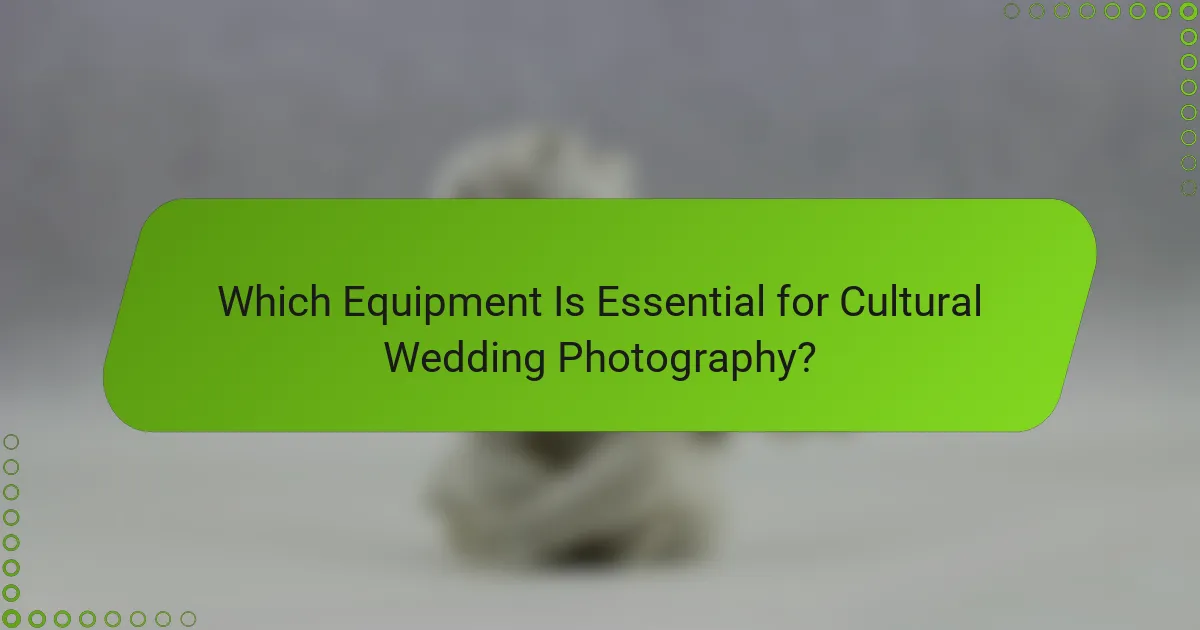
Which Equipment Is Essential for Cultural Wedding Photography?
Essential equipment for cultural wedding photography includes high-quality cameras, versatile lenses, stabilizing tools, and lighting accessories. These tools help capture the unique elements of cultural traditions, ensuring that every detail is preserved beautifully.
DSLR or mirrorless cameras
Choosing between a DSLR and a mirrorless camera depends on your shooting style and preferences. DSLRs offer robust battery life and an optical viewfinder, while mirrorless cameras are typically lighter and provide real-time exposure previews.
For cultural weddings, a camera with good low-light performance is crucial, especially during evening ceremonies or indoor events. Look for models with at least 20 megapixels for high-resolution images that can capture intricate details.
Wide-angle and telephoto lenses
Wide-angle lenses are essential for capturing large groups and expansive venues, allowing you to include more of the scene in a single shot. A lens with a focal length of 16-35mm is ideal for this purpose.
On the other hand, telephoto lenses, typically ranging from 70-200mm, are great for candid shots from a distance, enabling you to capture emotional moments without intruding on the ceremony. Having both types of lenses will give you the flexibility to adapt to various situations during the wedding.
Stabilizers and tripods
Using stabilizers and tripods is vital for achieving smooth, steady shots, especially in dynamic environments. A tripod is particularly useful for long exposure shots during low-light conditions, ensuring that your images remain sharp.
Consider a gimbal stabilizer for video work, as it helps eliminate shaky footage while moving. When selecting a tripod, look for one that can support your camera’s weight and is easy to transport.
External flash and reflectors
External flashes are crucial for illuminating subjects in low-light situations, such as evening receptions or indoor ceremonies. A flash with adjustable power settings allows you to control the light intensity, preventing harsh shadows.
Reflectors can enhance natural light, helping to fill in shadows on the couple’s faces. A collapsible reflector set is portable and can be easily positioned to direct light where it’s needed most, ensuring that every detail is beautifully lit.
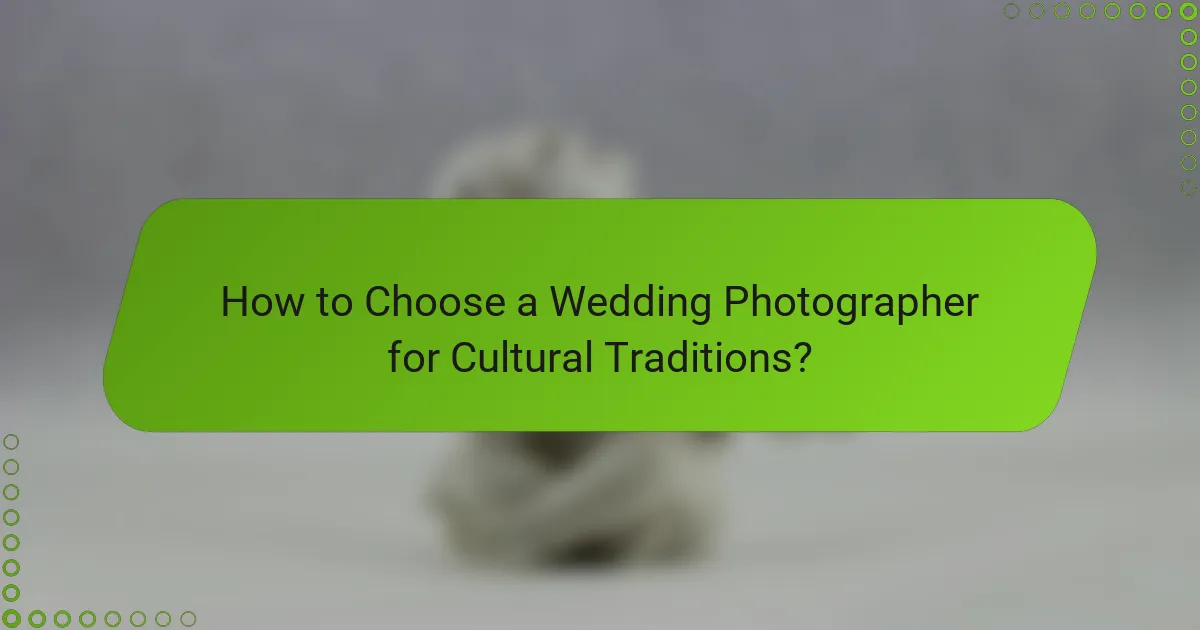
How to Choose a Wedding Photographer for Cultural Traditions?
Selecting a wedding photographer who understands and respects cultural traditions is crucial for capturing the essence of your celebration. Look for professionals who have experience with your specific cultural practices and can showcase them beautifully in their work.
Review portfolios for cultural experience
Consider the diversity of their work; a photographer who has experience with various cultural weddings may bring a unique perspective and creativity to your event. Pay attention to how they capture emotions and interactions during these traditions.
Check client testimonials
Client testimonials can provide insight into a photographer’s ability to handle cultural elements sensitively and effectively. Look for reviews that specifically mention the photographer’s experience with cultural weddings and how they engaged with the traditions.
Positive feedback from couples who share your cultural background can be particularly valuable. It indicates that the photographer not only understands the traditions but also respects and enhances them through their work.
Discuss cultural understanding
Before making a decision, have a conversation with potential photographers about their understanding of your cultural traditions. Ask them how they plan to incorporate these elements into your wedding photography.
Ensure they are open to discussing specific rituals, attire, and family dynamics that are important to you. A photographer who is genuinely interested in your culture will likely ask questions and offer suggestions to capture your wedding authentically.
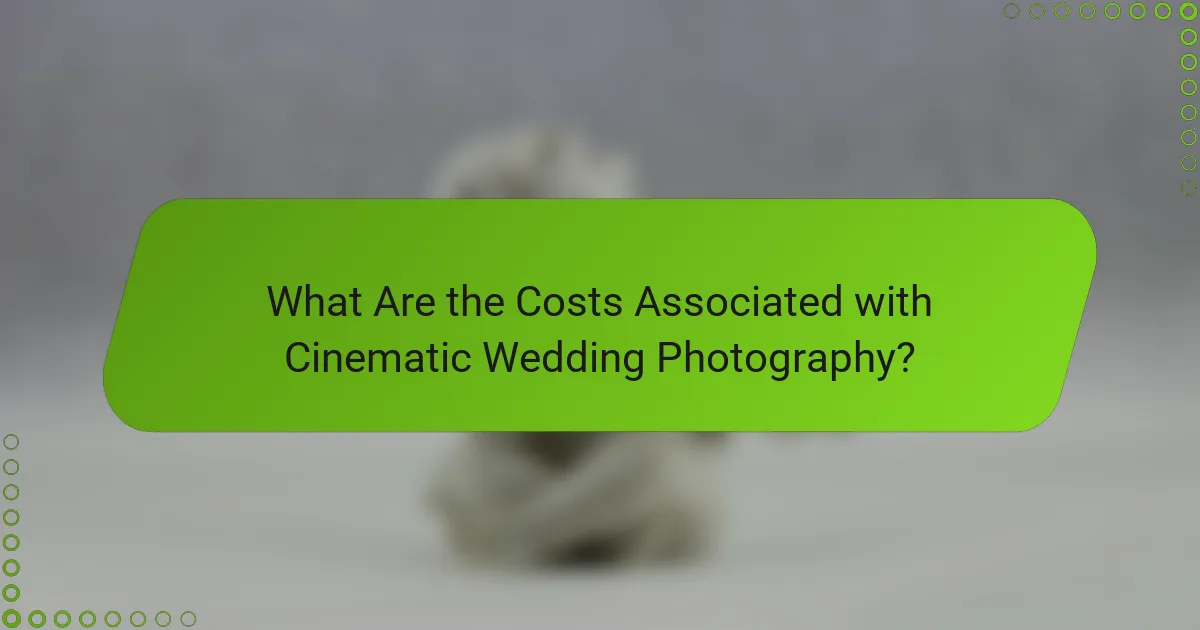
What Are the Costs Associated with Cinematic Wedding Photography?
The costs of cinematic wedding photography can vary significantly based on factors such as location, photographer experience, and the complexity of cultural traditions being captured. Couples should expect to invest a substantial amount, often ranging from a few hundred to several thousand dollars, depending on their specific needs and preferences.
Average pricing for cultural shoots
The average pricing for cultural wedding photography typically falls between $1,500 and $5,000 in the United States, but this can differ based on the region and the photographer’s expertise. For instance, in Europe, prices may range from €1,200 to €4,000, while in Bulgaria, couples might find packages starting around 1,000 BGN.
When considering cultural shoots, it’s essential to account for additional costs that may arise, such as travel fees for destination weddings or extra hours for capturing specific rituals. Photographers specializing in cultural traditions often offer tailored packages that include pre-wedding consultations to ensure all significant moments are documented.
To get the best value, couples should compare portfolios and reviews of different photographers, ensuring they align with the desired style and cultural significance. It’s advisable to discuss all potential costs upfront to avoid surprises later in the planning process.
